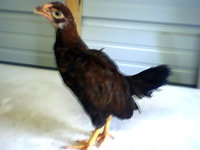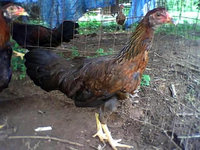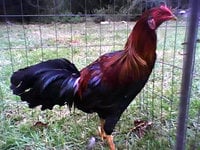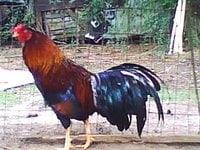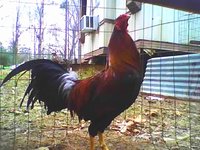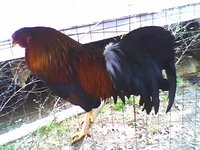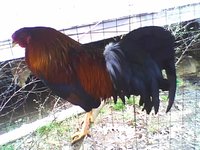General Information
- Comb
- Walnut
- Broodiness
- Average
- Climate Tolerance
- All Climates
- Egg Productivity
- High
- Egg Size
- Large
- Egg Color
- White/tinted
- Breed Temperament
- Calm, talkative.
- Breed Colors/Varieties
- BBred, White, Silver (US); many others in Europe.
- Breed Size
- Large Fowl
History
Kraienköppe (singular: Kraienkopp), also called the Twentse, are a little known about breed that were developed on the border region between Germany and the Netherlands, around 1850. The name Kraienköppe means something like “Crow head”, not necessarily because their head resembles a crow but it has been said they were actually called this due to how frequently they crow until the name was changed to Twentse Grijze/Twentse Hoender to lessen confusion with the Breda breed who was frequently called Kraaikoppen. For many people, if you mentioned the breed name they would not even know what it was, let alone where it came from or the history behind it. This is due to the lack of information regarding this breed that is available- especially in the English language, as well as the breeds intense rarity throughout the North America's and a lack of breeders within the country of origin.
Most of the time if one were to ask someone, even those who are rather knowledgeable of the breed, about the history they may be able to list basic things that can be found fairly easily such as: Their name, region, date they were developed and more than likely they will refer to them as Pheasant Malay and Leghorn crosses: There is however far more to the story I believe than what is out there and I hope to bring this out with this article. If we trace the history of the Kraienköppe fowl, we can find that they originated from crosses between Belgium game, Malay, Old English Game and local landfowl.
One of the main contributions to the spread of this breed has been said that they were commonly sold for a reichsmark each so that people would have money for their taxes. During this time the count was said to own the water, light, and air and because of people polluting it with use of chimneys homeowners were charged an annual tax of one reichsmark.
Their main purpose originally was that of the cockfight, during this period they were even given the name Biethaon (biting fowl). I have not been able to find any information regarding what breeds went into the local landfowl, but every other breed within the development of the Kraienköppe were gamefowl except Leghorns. Some people I have noticed tend to look over their gamefowl heritage or even try to argue it away and prefer to think of them only as Pheasant Malay and Leghorn crosses. Malay, as well as Old English Game's histories can be found pretty easily. But with Belgium Gamefowl however, this is not always the case. When we look at Belgium Gamefowl, we find three different types, the main one being the Brüges game, the eldest of the three, with the other two being the Liège and Tirlemont Gamefowl, which are crosses of the Brüges Gamefowl.
The Brüges fowl were developed from crosses between Old English Gamefowl, The Combattant Du Nord (Fighter of the North, basically French Gamefowl), and various type of Oriental Gamefowl with even Sumatra being a contribution to the breed as well since at one point they were a game breed. When looking at the rarest of fowl in these breeds again, the inevitable breed of choice would be the Combattant Du Nord.
When we look at the Combattant Du Nord, we find that it is a breed dating back to that of Julius Ceaser, roughly between 100-44 B.C. It is said the breed was discovered by him when he invaded Gaul. They were bred in the region of Nord-Pas-de-Calais, originating from Oriental game crosses with most likely that of the Old English Fowl or even their progenitors that possibly came from somewhere like Phoenicia, which had and fought gamefowl over three thousands years ago and introduced them into other countries by seafarers.
However, despite the gamefowl heritage of this breed, they are no longer a game breed. When cockfighting was outlawed in Belgium and exhibition interests were not of great importance, Leghorns were added to the breed to develop a hardy egg layer. In 1925, the breed made its first debut as a exhibition breed and shortly thereafter in the 1940's the bantam version (ZwergKraienköppe) was created by Dutch breeders Zienmerink and Ten Carte.
During this period, the bantams could be found only in the Silver Duckwing variety, and by the 1950's they had been imported to Germany and became recognized by the SV. Later they developed a Black Breasted Red variety and on the 10th of August, 1958, the bantams were introduced to the AGM; and by 1963 they were approved by the BZA.
During this period, the Silver varieties were superior over that of the Black Breasted Red; though both were well represented. The Dutch Specialty Club (THC) agreed upon the average weight for cocks to be from 2 pounds to 2.2 pounds, with hens having an average weight from 1.3 pounds to 2 pounds. This resulted in the bantams being considered better than before, as they had broad shoulders where it was often too short, the head was rather pointed and the wings often had a very angular transition.
After 45 years, by modifying the standard it opened the possibility to develop new varieties. It was agreed though, however, that they would support only the original varieties. Immediately afterwards, the Blue Red and Wheaten varieties appeared and were recognized in 2004. There are some breeders that are working on Blue Silver Duckwings, as well as Golden Duckwing bantams with hopes of getting them recognized. In the Netherlands though, only the Silver Duckwings and Black Breasted Reds are recognized.
The American Kraienköppe all came from one person originally to my knowledge. During the early-mid 1900’s Horst Schmudde had eggs imported from Germany and from what I have heard Craig Russell in turn purchased his stock from Horst Schmudde which is where all of the common hatchery strains came from.
Breed Characteristics
Externally, there are a few visible characteristics to that of their Oriental Gamefowl heritage, such as the curved, short, broad head with a protruding brow ridge and walnut comb, as well as the short, strong beak and small wattles. They also possess very strong, powerful yellow legs from that of their Malay heritage and tight-fitting feathers with fairly broad shoulders.
Personality wise, they're a lively and active breed that is quite hardy. The cocks are protective and will sometimes even fight off predators, but are generally tame and docile towards humans and are very curious. The hens are good layers especially during the cold months and can lay up to 200 off-white eggs per year if given the proper care and breeding selection.
Due to poor breeding in the United States, the American Kraienköppe differ from that of the Europe fowl in that they may have white legs, high set tails, single, walnut, or even pea combs. They also can be rather flighty, while the European birds have been said to be similar to puppies that will follow you around the yard much like that of Oriental Gamefowl. It is believed that Old English Game may have been added to the American Kraienköppe, given that among the white legs and single combs one can also find birds that almost resemble Old English in every way, as well as them having a broody nature while Kraienköppe from their homeland are not typically broody. Other breeds that have been suggested may have been added to the mix are Cubalaya due to the white legs, pea combs, and some birds having rather long tails. Still yet, some suggest Leghorns to have been added which is why they have single combs, white legs, and white earlobes sometimes. Though in truth this could all be the result of just poor breeding as is sometimes even evident in their homeland though they do not have these issues as frequently.
There are plans to hopefully correct these faults and help make the Kraienköppe more popular in North America, but as of right now literally only a handful of breeders have them and most are just hobbyist's. The only difference that may possibly differentiate between the American fowl and European strains in years to come would be that the broody trait may be kept.
Sources
Daniel Thornton
Additional Notes
Throughout the article, one may notice that the breed name is spelled differently than seen elsewhere; it is spelled "Kraienkoeppe" rather than the common "Kraienkoppe". The actual name has an umlaut over the O in "koppe", so anytime one is not able to use an umlaut there is supposed to be a e that follows the letter.
The second note, since many (including myself for some time) were not sure of the correct pronunciation; the name is pronounced "cray-in-cope-uh" or for a single bird "cray-in-cope".
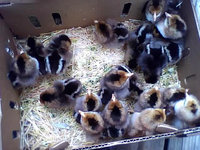
Kraienköppe chicks
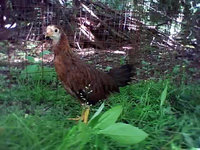
Kraienköppe juvenile
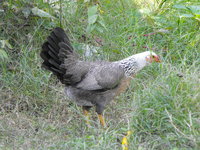
Kraienköppe hen
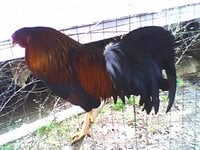
Kraienköppe rooster
For more information on this breed and their owners' and breeders' experiences with them, see our breed discussion here: https://www.backyardchickens.com/threads/chicken-breed-focus-kraienköppe.1085143/

